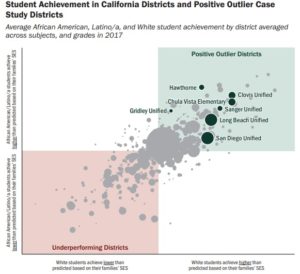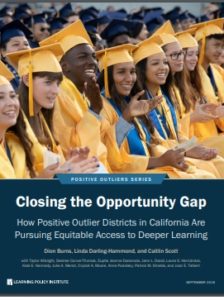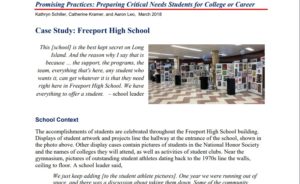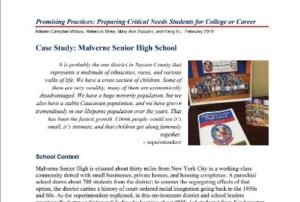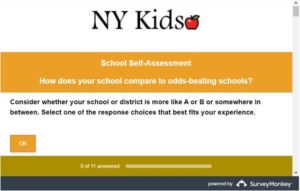The Role of District Leaders in Supporting Deeper Learning
By Amanda Lester and Kristen C. Wilcox
As noted in a recent Learning Policy Institute (LPI) report, Closing the Opportunity Gap: How Positive Outlier Districts in California Are Pursuing Equitable Access to Deeper Learning (also discussed in this NYKids’ blog), policymakers have often focused on individual schools when implementing improvement efforts. However, recent research has shown that system-level changes have considerable influence on school outcomes. As such, district leaders and staff have been found to be key in helping make the types of changes needed for school-level leaders and staff to successfully employ approaches shown to improve student success, such as deeper learning.
Deeper learning, as discussed in our prior blog on this report, is rooted in the idea that for students to find success in a constantly-changing society hallmarked by rapid innovation, each young person must be supported in developing competencies in critical thinking, problem-solving, collaboration, and communication.
Resource allocation, hiring and personnel support, instructional leadership, student discipline, and family engagement practices are among the myriad of district-level leader and staff concerns. Each of these concerns, and more so in combination, can significantly influence the capacity of school-level staff to engage students in deeper learning opportunities.
Policy Recommendations to Support Deeper and More Equitable Opportunities for Learning
Noting the relationship between federal, state, and local policy decisions, the LPI report concluded that supporting deeper learning and equity for all students through enabling policy environments is a critical lever for improvement. In the report, five broad policy recommendations were offered, along with specific recommendations at each level. The five broad recommendations (with district-level recommendations featured) are:
1. Develop a stable supply of well-prepared, instructionally engaged teachers and leaders.
District policymakers should prioritize hiring and mentoring well-prepared teachers who are committed to teaching every child and developing school leaders who create supportive working environments. This can include providing professional development and leadership opportunities for teachers.
2. Support capacity-building for high-quality instruction and focused instructional change.
District policymakers can provide high-quality professional learning opportunities for educators to help them implement and develop new instructional strategies that support deeper learning.
3. Use assessments and data strategically to support continuous improvement.
District policymakers and school leaders can use assessment tools, analysis of student work, survey data, and other indicators to improve school climate, shape teaching and learning, and identify and address student needs. District policymakers can support professional learning and establish structures for data to be analyzed and used effectively in continuous improvement cycles.
4. Create coherent systems of support based on student needs, including academic, social, and emotional learning.
District policymakers can implement multi-tiered systems of support to meet students’ academic, social, and emotional needs, and foster inclusive student assignment policies. They can also increase support for specialized and integrated English language development in mainstream classes.
5. Allocate resources for equity.
District policymakers can put resources into work that increases adequacy and equity, including building and funding supports for struggling students. This should include investing in and mentoring expert teachers who teach students with greater needs.
Lessons Learned about District Support for Deeper Learning in NYKids’ Odds-Beating Schools Mirror Those in California
The latest NYKids study identified odds-beating schools that succeeded in achieving above-predicted graduation rates for a number of subgroups of students including African-American, Latino/Hispanic, English language learners, and economically disadvantaged. Notable in these odds-beaters were several features of district support for deeper learning—mirroring the CA schools in the LPI report.
At Freeport in Long Island, NY, for example, district leaders focus on
- Hiring practices that support their relatively large Spanish-speaking and immigrant student population
- Developing and offering a diverse academic program aligned with student interests in mind
- Offering a wide variety of social-emotional support services that can be tailored to varying student and family needs
These specialized student supports enable teachers to co-construct a humanizing school community that fosters student performance by intentionally drawing upon their skills and knowledge as qualified educators.
“And then [newly arrived immigrant youth] are thrust into a new high school with a new language and are expected to perform academically,” “…unless we, as an institution, understand that we have to service the whole child and not just make sure they pass a test and graduate, we’re not going to find continued success.” – Freeport district leader
Despite challenges with recruitment and retention of highly qualified staff (challenges common in rural schools), Shelburne-Earlville Central School District, a rural school district in central NY, continues to attract, develop, and retain well-prepared teachers and leaders. District leaders there focus on:
- Offering instructional supports for students based upon their needs
- Developing new courses to engage students with different interests and desires to work in their or other rural communities through an Agricultural Science program
But the main real value is really just making sure that we try to provide what we can for each student based on their individual needs. Whether they’re students with disabilities, whether they’re students that require enrichment – those are the things we focus on. What can we do for the students? Whether it’s academic – we’ve increased the number of AP courses that we offer, we’ve increased the number of college credit-bearing courses that we offer. We’re bringing back an Agricultural Science program, slowly but surely. So that’s another piece to meet the needs of our community because we are an agricultural community. – Sherburne-Earlville district leader
Staff at Malverne Central School District, a working-class community on Long Island, benefit from a clear and coherent vision of success across the district.
In this vision, district leaders have prioritized:
- Making clear that high expectations for learning for every child is a top priority
- Building strong relationships between adults and students
- Empowering staff to lead initiatives that engage each and every student
At Malverne, teachers share the mantra of “Dream Big”: A guiding principle evident throughout the entire school district.
…We took the prototype of the Dare to Dream program and it came up to the high school with the children from the middle school each year. We then embedded it into the elementary school so that each cohort would have that whole vision, more or less, and support. So, then we said, let’s define success. Success has got to be the total person. It’s got to start with attitude, behavior, well-being and safety. Then it has to go to academic achievement and personal achievement. We then created the vehicles for input from staff, what would be of interest of them?, to complement the academic program. Then we built the academic program on the philosophy that all kids can achieve and will achieve at a higher level. – Malverne district leader
The lessons learned from positive outlier districts in California, and odds-beating schools in New York, provide important insights into the impacts district leaders and staff have on students’ opportunities for deeper learning.
Learn More About Odds-Beaters in California and New York
To learn more about the LPI report featured in this blog, click here to access video and other resources resulting from the report’s launch event. Another LPI report, California’s Positive Outliers Districts Beating the Odds, describes the larger mixed-methods project and serves as the anchor for reports included in LPI’s Positive Outlier report series.
The NYKids website features a host of resources such as case studies and reports highlighting lessons learned from odds-beating schools in New York State, a new sample survey tool to see how your school compares to others, and COMPASS, a unique direct support opportunity that guides district & school teams to use continuous school improvement processes and tools. To learn more, visit: https://ny-kids.org/.

